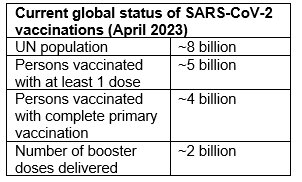Are we seeing a drop in SARS-CoV-2 vaccinations and boosters and what effect is this likely to have?
What the research says

Uptake of primary SARS-CoV-2 vaccination plateaued in 2022 at around 75% in most countries reporting data to the WHO COVID Vaccine Tracking project (203 countries; (WHO COVID-19 Vaccine Dashboard 2023). Uptake of booster vaccinations also plateaued in 2022 with most countries achieving coverage of <50% of the population (WHO COVID-19 Vaccine Dashboard 2023). A small number of countries have achieved booster vaccination rates as high as 75% (including Chile and China).
High levels of both primary vaccination and booster vaccination uptake are required to provide and maintain population-level immunity, reduce the level of circulating virus and reduce the risk for the emergence of novel variants (Abdelaziz Abdelmoneim et al 2022). Lack of population-level immunity permits ongoing viral circulation, an increase in cases of severe illness and death and the continued risk of the emergence of novel variants, especially as immunity conferred by both primary and booster vaccinations wanes over time (Corrao et al 2022; Motta 2022).
The uptake and delivery of booster vaccinations is considerably lower than for primary vaccinations in all countries.
(Table; WHO COVID-19 Vaccine Dashboard 2023).Pneumococcal vaccination)
The delivery of booster vaccinations has been particularly poor in low income countries with ~11 million booster doses delivered for a UN population of ~735 million individuals (coverage ~15% of the population) compared with ~557 million booster doses for a population of ~1.2 billion individuals in high income countries (coverage ~45% of the population; WHO COVID-19 Vaccine Dashboard 2023).
In terms of COVID-19 infections, the spike in confirmed cases has been considerably higher for December 2022-Janaury 2023 than compared with December 2021-January 2022, more short-lived and associated with considerably fewer deaths (WHO COVID-19 Dashboard 2023).
The situation with regard to prevalent viral subtypes and the development and approval of new vaccinations for booster programmes is continually evolving.
What the research says
- Continue to encourage patients, especially those at increased risk for more severe illness from SARS-CoV-2 infection, to consider additional COVID-19 booster vaccinations as recommended in your National Guidelines.
- Remind patients that low uptake of booster vaccination will result in a lack of population-level immunity and permit ongoing viral circulation which leads to an increased risk of further mutations to novel variants.
Resource information
- COVID-19
- Vaccination
